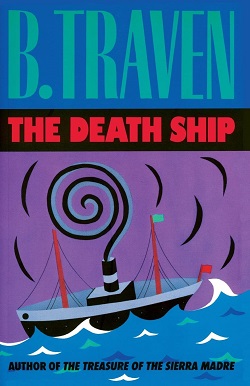Ending the Month With B. Traven’s “Capricious Woman”
By Stuart Mitchner
I was willingly drawn into the whole scene, like a random character in a B. Traven novel.
—Patti Smith, from M Train
 Mexico’s Mysterious Stranger” is the way James Agee characterized B. Traven in his February 2, 1948 Time review of John Huston’s film adaptation of The Treasure of the Sierra Madre. I’ve been haunted by Traven’s multi-faceted invisibility ever since last week’s column on the “disappearing poet” Weldon Kees, who told a friend in his last phone call in May 1955: “I may go to Mexico. To stay.” My interest in Traven began in earnest on Albert Einstein’s birthday, March 14, Pi Day in Princeton, after hearing that Traven’s The Death Ship (Das Totenschiff), published in German in 1926, is the novel Einstein named when asked what book he’d take to a desert island.
Mexico’s Mysterious Stranger” is the way James Agee characterized B. Traven in his February 2, 1948 Time review of John Huston’s film adaptation of The Treasure of the Sierra Madre. I’ve been haunted by Traven’s multi-faceted invisibility ever since last week’s column on the “disappearing poet” Weldon Kees, who told a friend in his last phone call in May 1955: “I may go to Mexico. To stay.” My interest in Traven began in earnest on Albert Einstein’s birthday, March 14, Pi Day in Princeton, after hearing that Traven’s The Death Ship (Das Totenschiff), published in German in 1926, is the novel Einstein named when asked what book he’d take to a desert island.
The “American” Sailor
Apparently born in Germany in February 1882, the man who claims never to have laid eyes on his birth certificate died in Mexico City on March 26, 1969, a coincidence it’s hard to ignore on March 26, 2025 — which is why I’m reading Einstein’s desert island novel, subtitled The Story of An American Sailor. The fact that Traven himself translated the book into English helps explain certain peculiarities in the easygoing conversational narrative by a German castaway passing himself off as an American while casually referring to Cincinnati as a city in Wisconsin. Left behind by an American ship, without papers or passport, the sailor is shunted by various immigration authorities from Belgium to Holland to France to Spain, where he boards a massively devastated ship called the Yorikke, no doubt after the “fellow of infinite jest” whose skull Hamlet muses over prior to the “death ship” of Shakespeare’s ending.
She’s a Woman
The epigraph from Patti Smith about being in a Traven novel is a sort of a nod to Women’s History Month, which was somewhat degraded by the wording of the president’s March 6 proclamation. You might think it a weird connection in any case since the book has a virtually all-male cast — until you get to the jazzy, comical, freewheeling cadenza revealing that the novel’s most important character, the first “real female,” is in fact the death ship.
Traven takes the age-old association of ships with women to another level. The sailor-narrator’s first look at “this old maiden” Yorikke rouses in him an outburst of “thundering laughter” — her masts like “branches reaching out from a fantastic tree in North Dakota in November,” her funnel “crooked and bent like a corkscrew,” her bridge as if unconnected “to the rest of her.” At the sound of his laughter, “She trembled all over and began to glide backwards along the bulks,” not wanting to go out into the open water, knowing “she might never come back. She grazed and scratched along the heavy timbers of the pier, making a squeaking, piercing noise.” Seeing her struggling so hard against the orders of her skipper, the sailor begins to pity her. “It was like dragging old Aunt Lucinda, who had never been away from her native town, Jetmore, Kansas, into a bathing suit and out upon a diving board thirty feet above the ocean.”
Meanwhile her crew is “working like hell to get her going on her way…. What could an old defenseless jane like her do against the rough fists of so many rum-soaked guys? Scratch and squeal and squeak she might, and bite, but it won’t do her any good. She simply has to snap out of it and get it over and make off…. She couldn’t be blamed for her behavior…she was no longer as young and springy as she was when she stood by to guard Cleopatra’s banquets for Antony. Were it not for the many thick coats of paint on her hull, she would have frozen to death in the cold ocean, for her blood was no longer as hot as it was five thousand years ago.”
Translating Traven
In a 1970 article in the New York Times Book Review, Bernard Smith, who edited The Death Ship for Knopf in the 1930s, recalls that he worked from an English-language manuscript supplied by Traven, but that it had to be heavily edited because it was filled with Germanic constructions. Smith thinks that Traven “translated his own German into English literally, embellishing it occasionally with what he took to be American colloquialisms. Every other sentence was German in construction.” Smith’s mission was to make the book readable while retaining its “special flavor.”
As if propelled by the wild outburst at the end of The First Book, the prose becomes much more descriptive in the Second, accentuating the deadly truth of the dictionary definition of a “coffin ship” as “any ship that has been overinsured and is therefore worth more to its owners sunk than afloat.” Thus the reader enters the Yorikke in company with a sailor who boards her feeling that he’s entered “that big gate” over which is written: “He who enters here will no longer have existence.” The Dantesque legend is followed by a litany of edicts that reflect the author’s own lifelong commitment to disappearance: “his name and soul have vanished forever, he can never return, never ever go onward, no God knows him, he will be unknown in hell, he is not day, he is not night, he is Nothing and Never. He is what has never been and never thought.”
What Moved Einstein?
It’s a somewhat Travenesque situation reading an English version of a novel Einstein read and admired in the original German, most likely in 1928 while recovering from “a heart illness” that confined him to bed for several months. Reading the book in the post-inauguration America of March 2025, I took note of certain post-Great War references to the debts European countries amasssed fighting for democracy (“the money they borrowed from us when they were in a hole”) while “building up a better bureaucracy and a bigger police force.” Amusing encounters with bureaucrats and police of various countries asking the same questions over and over again leave the sailor asking himself, “Who is he that could stand a hundred questions and answer none?”
Einstein might have been struck by the sailor’s reference to an unanswered question “that flutters about you for the rest of your life. It does not let you sleep; it does not let you think. You feel that the equilibrium of the universe is at stake if you leave a question pendant….You get crazy thinking of the problems of an unbalanced solar system.” Speaking of the power of a one-word question that can create despots and destroy them, create new religions and reduce them to superstitions again, while making “a nebula of the real and the spiritual center of the universe, and it will again make the same nebula an insignificant speck in the super-universe… So what could I do, a sailor without papers, against the power of the word ‘Why?’”
Appearing in Person
In his long piece on John Huston and The Treasure of the Sierra Madre, James Agee says that during the scripting of the film, Huston was in constant correspondence with “its mysterious author who has lived invisibly, somewhere in Mexico for many years.” One day in a Mexico City hotel, “a frail little man in faded khaki, his shirt held together with a cheap gold pin, presented to Huston a card: Hal Croves, Translator.” Croves claimed to be there on Traven’s behalf, an old friend “who knew the author and his work better even than Traven himself did.” Huston hired Croves at $150 a week as a technical advisor. By the time Croves “had done his job and disappeared,” Huston was “pretty certain that uneasy little Mr. Croves was Traven himself.”
Patti Smith’s Remedy
In her 2019 memoir, The Year of the Monkey, Patti Smith offers a Melvillian remedy for insomnia wherein she imagines herself “a sailor in the time of the great whaling ships.” During a violent storm, the captain’s son is pulled overboard, the sailor leaps into the sea after him, saves the lad, is called into the captain’s inner sanctum and asked “how best can I serve you” for saving “my son’s life.” After asking for a full measure of rum for each member of the crew, the sailor says, “I have slept on galley floors, bunks and hammocks since a lad, it has been a long time since I have slept in a proper bed.” Moved by such humility, the captain offers his own bed, which has down pillows and a light coverlet. “The sailor crosses himself, blows out the candles” and settles into “a rare and wholly enveloping sleep.”
I’ve condensed and paraphrased Patti Smith’s remedy, which ends: “This is the game I sometimes play when sleep is elusive, one that evolved from reading Melville, that takes me from the mat on the bathroom floor to my own bed, affording grateful slumber.”’
A Sailor’s Love Song
When Traven’s sailor finds himself faced with the existential moment of signing his name and nationality into the register of a death ship, he abandons his American citizenship and settles for Helmond Rigby, Alexandria Egypt. Why not claim to be an American? Because no American in his right mind would ever sail on a death ship.
Once aboard the maiden Yorikke, the sailor finds time to speak of “that blue glorious sea which I loved better than I ever could think of loving a jane. That wonder of a sea, in which to be drowned as an honorable sailor when doing my duty I would have felt to be the greatest honor that could be bestowed upon me. That sea, that capricious woman whom alone I felt truly married to, that wonderful woman who can smile so charmingly, can sing such bewitching cradle-songs, that can rage so furiously, that can show such a savage and alluring temperament, and then fall asleep so sweetly and so dreamily that one could do nothing better than just kiss her and kiss her over and over again.”

